Unit 9 Have you ever been to a museum Section A(3a-3c)(课件)(19张PPT)
文档属性
| 名称 | Unit 9 Have you ever been to a museum Section A(3a-3c)(课件)(19张PPT) | 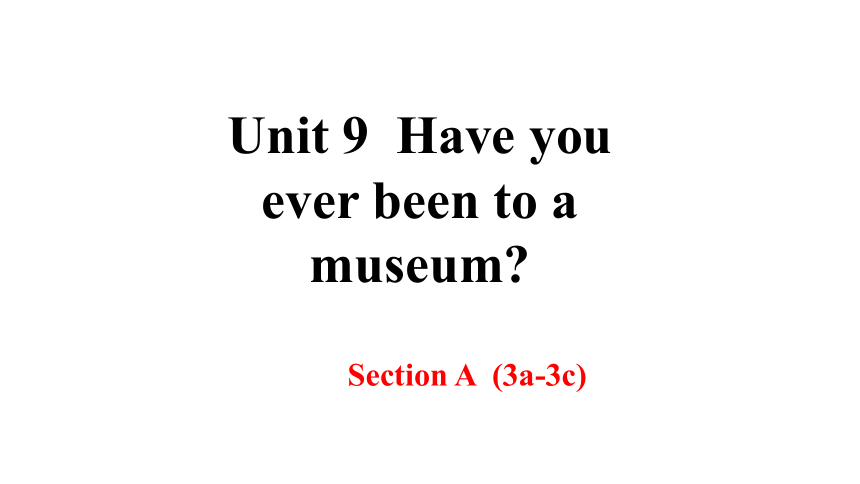 | |
| 格式 | pptx | ||
| 文件大小 | 1.7MB | ||
| 资源类型 | 教案 | ||
| 版本资源 | 人教新目标(Go for it)版 | ||
| 科目 | 英语 | ||
| 更新时间 | 2022-04-07 21:10:19 | ||
图片预览

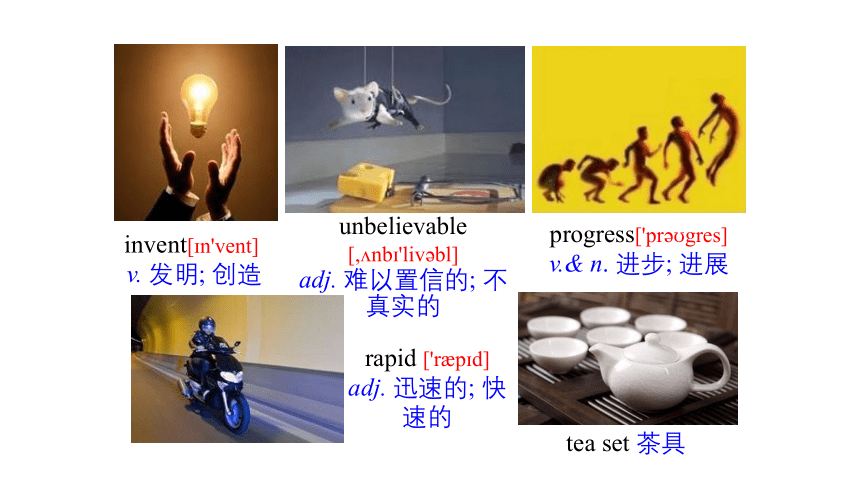
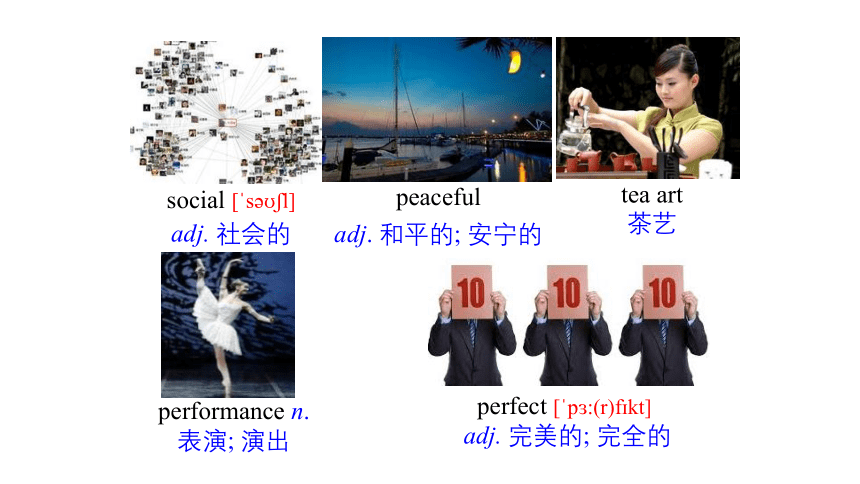
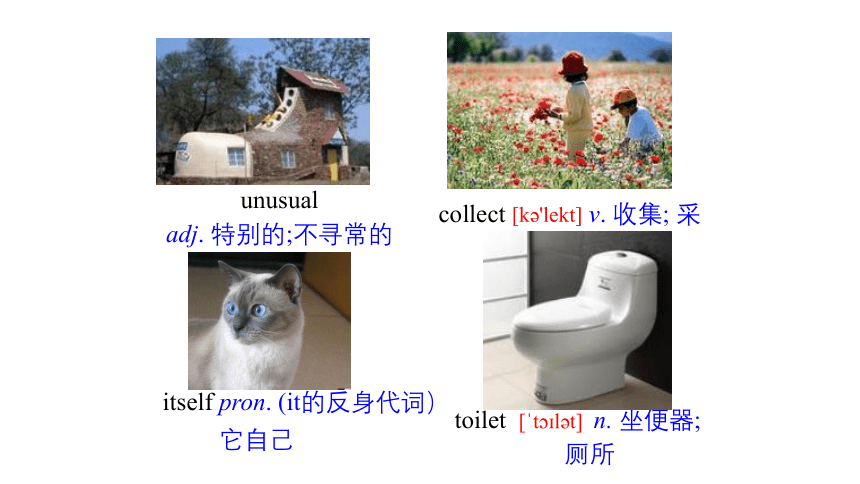
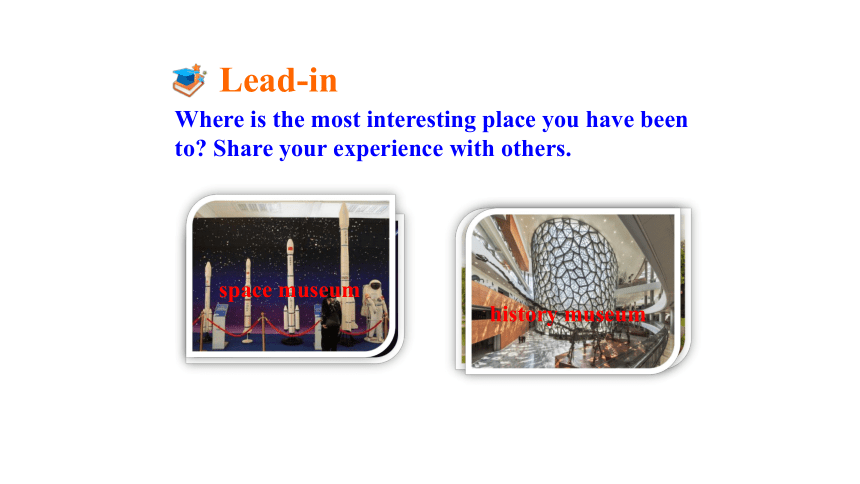
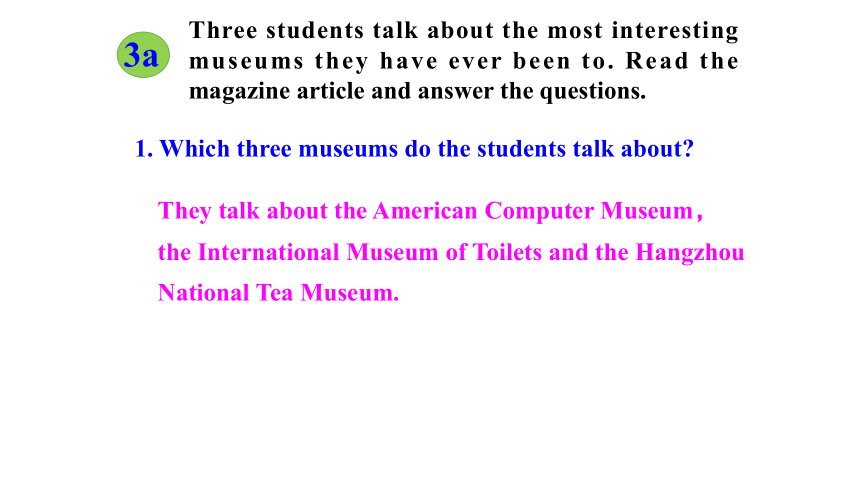
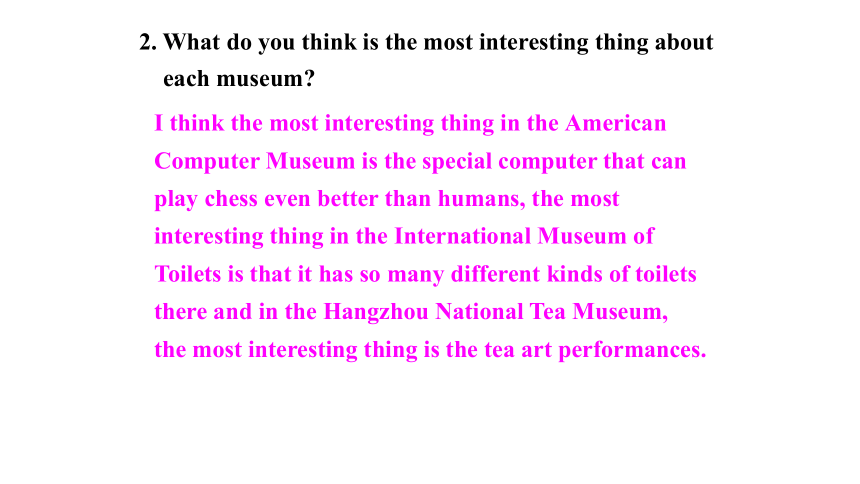
文档简介
(共19张PPT)
Unit 9 Have you ever been to a museum
Section A (3a-3c)
invent[ n'vent]
v. 发明; 创造
unbelievable
[, nb 'liv bl]
adj. 难以置信的; 不真实的
progress['pr gres]
v.& n. 进步; 进展
rapid ['r p d]
adj. 迅速的; 快速的
tea set 茶具
social [ s l]
adj. 社会的
peaceful
adj. 和平的; 安宁的
performance n. 表演; 演出
perfect [ p :(r)f kt]
adj. 完美的; 完全的
tea art
茶艺
itself pron. (it的反身代词)
它自己
collect [k 'lekt] v. 收集; 采集
toilet [ t l t] n. 坐便器; 厕所
unusual
adj. 特别的;不寻常的
Where is the most interesting place you have been to Share your experience with others.
computer museum
zoo
space museum
history museum
Lead-in
Three students talk about the most interesting museums they have ever been to. Read the magazine article and answer the questions.
3a
1. Which three museums do the students talk about
They talk about the American Computer Museum,
the International Museum of Toilets and the Hangzhou
National Tea Museum.
2. What do you think is the most interesting thing about
each museum
I think the most interesting thing in the American Computer Museum is the special computer that can play chess even better than humans, the most interesting thing in the International Museum of Toilets is that it has so many different kinds of toilets there and in the Hangzhou National Tea Museum, the most interesting thing is the tea art performances.
Ken:The most interesting museum I’ve ever been to is the American Computer Museum. They have information about different computers and
who invented them. The old computers were much bigger. It’s unbelievable
that technology has progressed in such a rapid way! I’ve also learned that
there was a special computer. It could play chess even better than humans. I wonder how much more computers will be able to do in the future.
表示“关于……的信息” information u.n.
一条信息:a piece of information
Para.1
invent v.发明 inventor n.发明家
invention n.发明(物)
adj. 难以置信的;不真实的
反义词:believable(可信的)
以如此快的方式
progress: ( v.& n.) 进步;进展。
固定搭配: make progress 取得进步,取得进展
eg. If you want to make progress, you must work hard.
make progress in … 在……方面取得进步
eg. The teacher hopes that I can make progress in science.
rapid: (adj.) ,迅速的;快速的。副词形式为rapidly
辨析 rapid、quick 与 fast
fast
quick
rapid
快的,一般指物体的运动速度快,常用来形容交通工具跑得快,钟表走得快,人的速度快等。
迅速的,快的;强调行动敏捷,反应迅速。
快的,指动作本身,意义比quick强。表速度之快往往可与fast通用,但它多指运动本身。
Amy:I’ve recently been to a very unusual museum in India, the
International Museum of Toilets. I just couldn’t believe my eyes when I saw so many different kinds of toilets there. The museum teaches people about the history and development of toilets. It also encourages governments and
social groups to think about ways to improve toilets in the future.
Para.2
最近
adj.不寻常的 反:usual 通常的
encourage sb. to do sth. 鼓励某人做...
encouragement n.鼓励
courage n. 勇气
社会组织
social adj. 社会的
society n.
Linlin:Last year I went to the Hangzhou National Tea Museum. It’s a relaxing and peaceful place near a lake. The tea art performances show how to
make a perfect cup of tea with beautiful tea sets. Watching the tea preparation
is just as enjoyable as drinking the tea itself. I’ve finally realized why my grandpa loves drinking tea and collecting tea sets.
Para.3
茶艺表演
沏一杯好茶
perfect adj.完美的
反:imperfect 不完美的,有缺点的
茶具
收集茶具
collect v.收集
collector n.收藏者
collection n.收藏,收藏品
动名词(短语)作主语时,谓语动词常
用第三人称单数形式。
3b
Read the article again and answer the following
questions.
1. What does Ken say about the American Computer
Museum
2. What can we learn at the International Museum of
Toilets
3. Why is the Hangzhou National Tea Museum a nice
place to enjoy tea
1. What does Ken say about the American Computer Museum
Ken says that : (a) it is the most interesting museum he has ever been to; (b) it has information about different computers and who invented them, and (c) he learned that there was a special computer that could play chess better than humans.
2. What can we learn at the International Museum of Toilets
We can learn about the history and development of toilets.
3. Why is the Hangzhou National Tea Museum a nice place to enjoy
tea
It is a nice place to enjoy tea because it is located in a relaxing and peaceful
place near a lake. Watching tea art performances is also enjoyable.
3c
Which of the underlined words in the passage have
the following meanings
make (something) better
improve
quiet
peaceful
become better
progressed
made
invented
uncommon
unusual
quick
rapid
根据课文内容填空。
The American Computer Museum has information about different computers and who________ them. The old computers were much ______. It’s ___________ that technology has _________ in such a _____ way!
invented
bigger
unbelievable
progressed
rapid
The International Museum of Toilets__________ people about the history and ___________ of toilets. It also __________ governments and social groups to _____ _____ ways to _______ toilets in the future.
teaches
development
encourages
think about
improve
The Hangzhou National Tea Museum is a relaxing and _______ place near a lake. The tea art performances _____ how to make a ______ cup of tea with beautiful tea sets. _________ the tea preparation is just ___ enjoyable ____ drinking the tea itself.
peaceful
show
perfect
Watching
as
as
Useful phrases
1.进步如此迅速
progress in such a rapid way
2.一个不同寻常的博物馆
an unusual museum
3.厕所的发展
the development of toilets
4.鼓励政府去改善它
encourage the government to improve it
5.一个平静的地方
a peaceful place
6.茶艺表演
7.收集茶具
8.泡一杯极好的茶
9.发明电脑
10.社会组织
11.一项发明
a tea art performance
collect tea sets
make a perfect cup of tea
invent computers
social groups
an invention
2. The suitcase looks too heavy for the lady to carry. Let’s
go to help her, ______
A. will you B. won’t you C. shall we D. do we
3.As we all have grown up, we should learn to look after
_____.
A. ourselves B. us C. myself D. we
4. _____ you ever _____ to Africa
A. Have; gone B. Have; been C. Do; go D. Were; going
Exercise
1. She encouraged him ____ to her.
A. talk B. talks C. talking D. to talk
1. Recite the new words and expressions by heart.
2. Finish off the exercises in Section A.
Unit 9 Have you ever been to a museum
Section A (3a-3c)
invent[ n'vent]
v. 发明; 创造
unbelievable
[, nb 'liv bl]
adj. 难以置信的; 不真实的
progress['pr gres]
v.& n. 进步; 进展
rapid ['r p d]
adj. 迅速的; 快速的
tea set 茶具
social [ s l]
adj. 社会的
peaceful
adj. 和平的; 安宁的
performance n. 表演; 演出
perfect [ p :(r)f kt]
adj. 完美的; 完全的
tea art
茶艺
itself pron. (it的反身代词)
它自己
collect [k 'lekt] v. 收集; 采集
toilet [ t l t] n. 坐便器; 厕所
unusual
adj. 特别的;不寻常的
Where is the most interesting place you have been to Share your experience with others.
computer museum
zoo
space museum
history museum
Lead-in
Three students talk about the most interesting museums they have ever been to. Read the magazine article and answer the questions.
3a
1. Which three museums do the students talk about
They talk about the American Computer Museum,
the International Museum of Toilets and the Hangzhou
National Tea Museum.
2. What do you think is the most interesting thing about
each museum
I think the most interesting thing in the American Computer Museum is the special computer that can play chess even better than humans, the most interesting thing in the International Museum of Toilets is that it has so many different kinds of toilets there and in the Hangzhou National Tea Museum, the most interesting thing is the tea art performances.
Ken:The most interesting museum I’ve ever been to is the American Computer Museum. They have information about different computers and
who invented them. The old computers were much bigger. It’s unbelievable
that technology has progressed in such a rapid way! I’ve also learned that
there was a special computer. It could play chess even better than humans. I wonder how much more computers will be able to do in the future.
表示“关于……的信息” information u.n.
一条信息:a piece of information
Para.1
invent v.发明 inventor n.发明家
invention n.发明(物)
adj. 难以置信的;不真实的
反义词:believable(可信的)
以如此快的方式
progress: ( v.& n.) 进步;进展。
固定搭配: make progress 取得进步,取得进展
eg. If you want to make progress, you must work hard.
make progress in … 在……方面取得进步
eg. The teacher hopes that I can make progress in science.
rapid: (adj.) ,迅速的;快速的。副词形式为rapidly
辨析 rapid、quick 与 fast
fast
quick
rapid
快的,一般指物体的运动速度快,常用来形容交通工具跑得快,钟表走得快,人的速度快等。
迅速的,快的;强调行动敏捷,反应迅速。
快的,指动作本身,意义比quick强。表速度之快往往可与fast通用,但它多指运动本身。
Amy:I’ve recently been to a very unusual museum in India, the
International Museum of Toilets. I just couldn’t believe my eyes when I saw so many different kinds of toilets there. The museum teaches people about the history and development of toilets. It also encourages governments and
social groups to think about ways to improve toilets in the future.
Para.2
最近
adj.不寻常的 反:usual 通常的
encourage sb. to do sth. 鼓励某人做...
encouragement n.鼓励
courage n. 勇气
社会组织
social adj. 社会的
society n.
Linlin:Last year I went to the Hangzhou National Tea Museum. It’s a relaxing and peaceful place near a lake. The tea art performances show how to
make a perfect cup of tea with beautiful tea sets. Watching the tea preparation
is just as enjoyable as drinking the tea itself. I’ve finally realized why my grandpa loves drinking tea and collecting tea sets.
Para.3
茶艺表演
沏一杯好茶
perfect adj.完美的
反:imperfect 不完美的,有缺点的
茶具
收集茶具
collect v.收集
collector n.收藏者
collection n.收藏,收藏品
动名词(短语)作主语时,谓语动词常
用第三人称单数形式。
3b
Read the article again and answer the following
questions.
1. What does Ken say about the American Computer
Museum
2. What can we learn at the International Museum of
Toilets
3. Why is the Hangzhou National Tea Museum a nice
place to enjoy tea
1. What does Ken say about the American Computer Museum
Ken says that : (a) it is the most interesting museum he has ever been to; (b) it has information about different computers and who invented them, and (c) he learned that there was a special computer that could play chess better than humans.
2. What can we learn at the International Museum of Toilets
We can learn about the history and development of toilets.
3. Why is the Hangzhou National Tea Museum a nice place to enjoy
tea
It is a nice place to enjoy tea because it is located in a relaxing and peaceful
place near a lake. Watching tea art performances is also enjoyable.
3c
Which of the underlined words in the passage have
the following meanings
make (something) better
improve
quiet
peaceful
become better
progressed
made
invented
uncommon
unusual
quick
rapid
根据课文内容填空。
The American Computer Museum has information about different computers and who________ them. The old computers were much ______. It’s ___________ that technology has _________ in such a _____ way!
invented
bigger
unbelievable
progressed
rapid
The International Museum of Toilets__________ people about the history and ___________ of toilets. It also __________ governments and social groups to _____ _____ ways to _______ toilets in the future.
teaches
development
encourages
think about
improve
The Hangzhou National Tea Museum is a relaxing and _______ place near a lake. The tea art performances _____ how to make a ______ cup of tea with beautiful tea sets. _________ the tea preparation is just ___ enjoyable ____ drinking the tea itself.
peaceful
show
perfect
Watching
as
as
Useful phrases
1.进步如此迅速
progress in such a rapid way
2.一个不同寻常的博物馆
an unusual museum
3.厕所的发展
the development of toilets
4.鼓励政府去改善它
encourage the government to improve it
5.一个平静的地方
a peaceful place
6.茶艺表演
7.收集茶具
8.泡一杯极好的茶
9.发明电脑
10.社会组织
11.一项发明
a tea art performance
collect tea sets
make a perfect cup of tea
invent computers
social groups
an invention
2. The suitcase looks too heavy for the lady to carry. Let’s
go to help her, ______
A. will you B. won’t you C. shall we D. do we
3.As we all have grown up, we should learn to look after
_____.
A. ourselves B. us C. myself D. we
4. _____ you ever _____ to Africa
A. Have; gone B. Have; been C. Do; go D. Were; going
Exercise
1. She encouraged him ____ to her.
A. talk B. talks C. talking D. to talk
1. Recite the new words and expressions by heart.
2. Finish off the exercises in Section A.
同课章节目录
- Unit 1 What's the matter?
- Section A
- Section B
- Unit 2 I'll help to clean up the city parks.
- Section A
- Section B
- Unit 3 Could you please clean your room?
- Section A
- Section B
- Unit 4 Why don't you talk to your parents?
- Section A
- Section B
- Unit 5 What were you doing when the rainstorm came
- Section A
- Section B
- Review of Units 1-5
- Unit 6 An old man tried to move the mountains.
- Section A
- Section B
- Unit 7 What's the highest mountain in the world?
- Section A
- Section B
- Unit 8 Have you read Treasure Island yet?
- Section A
- Section B
- Unit 9 Have you ever been to a museum?
- Section A
- Section B
- Unit 10 I've had this bike for three years.
- Section A
- Section B
